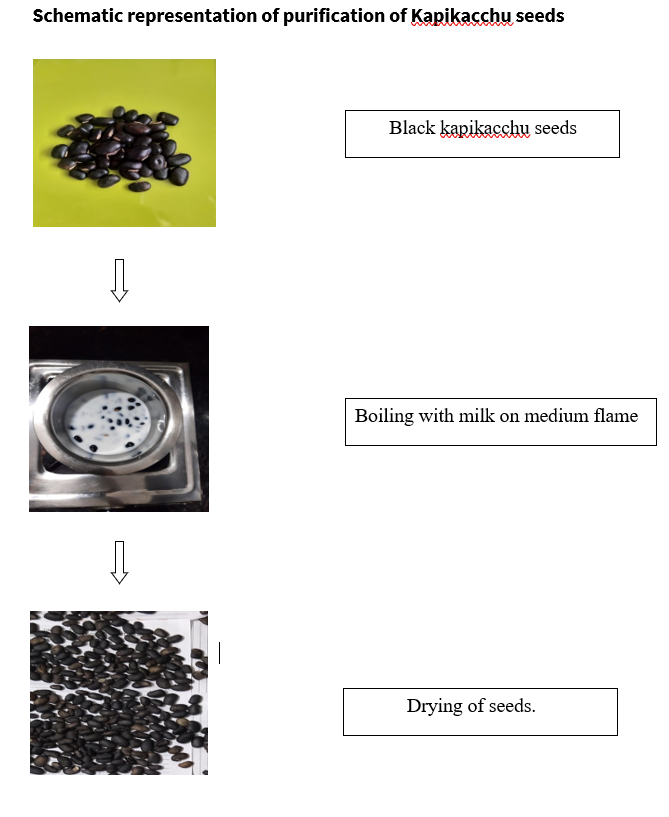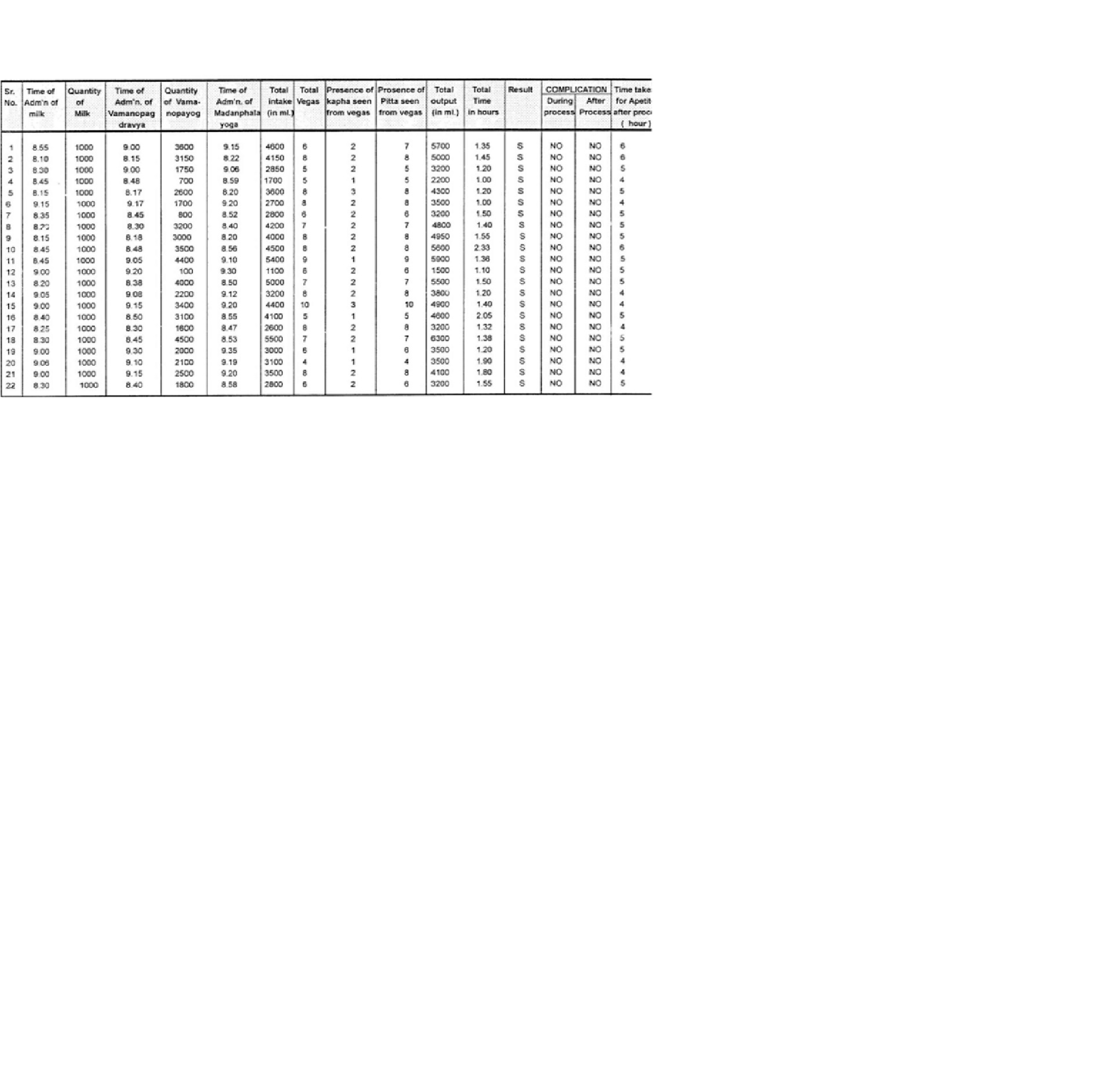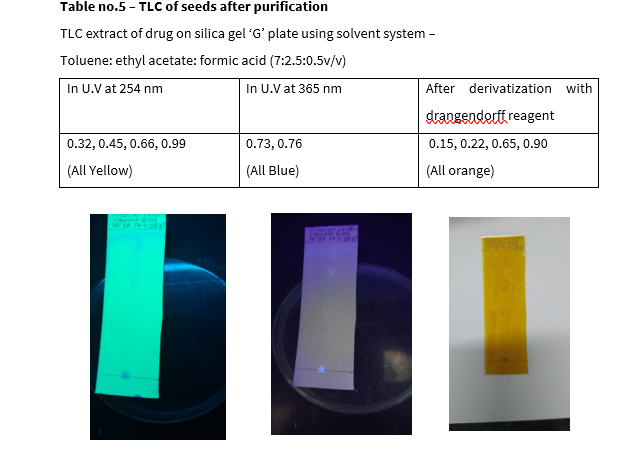Review Article
Year: 2021 |Volume: 2 | Issue: 11 |Pages: 24-32
Analytical comparison of Kavach Beej before and after purification
About Author
Correspondence Address:
Dr. Shravan Sheth PG scholar, Dept of Rasshastra and Bhaishajya Kalpana, YMT Ayurvedic medical college Kharghar, Navi Mumbai. Email: shethshravan93@gmail.com
Date of Acceptance: 2021-11-10
Date of Publication:2021-12-07
Article-ID:IJIM_120_12_21 http://ijim.co.in
Source of Support: Nil
Conflict of Interest: Nil
How To Cite This Article: Sheth S, Deshmukh A. Analytical comparison of Kavach Beej before and after purification. Int J Ind Med 2021;2(11):24-32
Abstract
Mucuna pruriens Linn. is a popular Indian medicinal plant, which has been used, in traditional Ayurvedic Indian medicine for diseases including parkinsonism. According to Ayurvedic literature Kapikacchu is used as a potent aphrodisiac. Kapikacchu (Mucuna pruriens (L.) DC.) belonging to the family Fabaceae is commonly known as Velvet bean, Cowitch, Cowhage in English and Kawaanch, Kavach in Hindi. It is mainly distributed in Asia, Africa, Pacific Islands and the United State. In market two types of seeds (black and white) are available and are being used simultaneously in the name of Kapikacchu. Normally black seeds are being used for medicinal purpose. No data is yet available in context with process of purification of Kapikacchu seeds. The aim of present article is to put forward the comparative physicochemical analysis of Kapikacchu seeds before and after purification.
Keywords: Kapikacchu, Shodhan, visha varga ,Godugdha
Introduction
Ayurveda the upveda of Atharvaveda deals with herbal and minerals drugs for prevention and cure of diseases. Ayurveda has briefly demonstrated the taxonomy, genus, species, availability, collection, purification, properties and therapeutic uses of herbo-mineral drugs. Herbal medicines have been widely used all over the world since ancient times. Herbal remedies have lesser side-effects as compared to modern medicines. In present scenario, the need of basic scientific investigation on medicinal plants used in indigenous system becomes imminent.
Ayurveda defines the concept of shodhana for metals, minerals and herbal compounds. There are references available in ayurvedic classics but details of shodhan process is traced after development of Rasashatra. Some herbal drugs such as visha varga are also purified before utilization for medicinal purpose. The shodhan in modern language is known as purification. In this process of shodhan not only physical and chemical and toxic materials are eliminated, but there is also conversion of properties to make them in pharmaceutically suitable form, in which they may be absorbed into the system when used internally or externally.[1] It also increases potency of drug material, and induce desired qualities for further processing.
Kavach beej is herbal drug spread throughout the world having almost 150 species belonging to fabaceae family[2]. It is famous for its aphrodisiac activity by increasing testosterone levels in the body ultimately increasing sperm count. This plant is well mentioned in many ayurvedic texts. Kapikachhu seeds contain L-Dopa which is indicated in Parkinson’s disease and used as aphrodisiac. L-Dopa is precursor of the neurotransmitter Dopamine[3] But there is no data available yet for purified beeja of kapikacchu. In context with this the aim of present article is to put forward the comparative physicochemical analysis of Kapikacchu seeds before and after purification.
Sr. no.
Content
Proportion
Quantity
1.
Kavach beej (whole seed)
1 part
750gms
2.
Godugdha
4parts
3lit
Procedure followed for purification of kapikacchu - 750gms of kappikacchu seeds were taken in the SS vessel having capacity of 5L. Four times Godugdha (3L) was added to it and the mixture was boiled on medium flame for 3 hours. When the solution gets concentrated then Kapikacchu seeds were separated out from the Go-dugdha. After then seed coat of Kapikacchu was removed from seeds. These seeds are dried and were purified seeds of Kapikacchu and were subjected for physicochemical analysis with non-purified kavach beej.
-
Determination of Moisture Content:[5] Moisture content was determined of both the seeds before and after purification, by placing weighed sample each 5gm of drug in oven at 105ºC for 5 hours. Then the sample was allowed to cool at room temperature in a desiccator and weighed it properly.
-
Determination of pH: [6] The pH value of an aqueous liquid may be defined as the common reciprocal of the hydrogen ion concentration expressed in gram per litre. It practically means the quantitative indication of the acidity or basic nature of a solution. pH value was calculated as per the methods mentioned in the Ayurveda Pharmacopeia of India. (1% solution at 33?C)
-
Determination of Extractive values:[7] Determination of Alcohol Soluble Extractive: Alcohol-soluble extractive value was calculated as per the methods mentioned in the Ayurveda Pharmacopeia of India. Determination of water soluble extractive: Procedure was same as that of alcohol soluble extractive value and it was proceeded using distilled water instead of alcohol and 2-3 drops of chloroform was added to the mixture.
-
Determination of Total Ash:[8] The total ash method is designed to measure the total amount of material remaining after ignition. This includes both physiological ash which is derived from the plant tissue itself and non-physiological ash which is the residue of the extraneous matter (e.g sand and soil) adhering to plant surface. Total Ash value was calculated as per the methods mentioned in the Ayurveda Pharmacopeia of India.
-
Determination of Acid Insoluble Ash:[9] Acid insoluble ash value was calculated as per the methods mentioned in the Ayurveda Pharmacopeia of India.
-
Chromatography:[10] Thin-layer chromatography is a technique in which a solute undergoes distribution between two phases, a stationary phase acting through adsorption and a mobile phase in the form of a liquid. The adsorbent is a relatively thin, uniform layer of dry finely powdered material applied to a glass, plastic or metal sheet or plate. Glass plates are most commonly used. Separation may also be achieved on the basis of partition or a combination of partition and adsorption, depending on the particular type of support, its preparation and its use with different solvent. Identification can be effected by observation of spots of identical Rf value and about equal magnitude obtained, respectively, with an unknown and a reference sample chromatographed on the same plate. A visual comparison of the size and intensity of the spots usually serves for semiquantitative estimation.
" ROWS="50" class="form-control">
Materials and methods:
We took Kapikacchu seeds (black) from local market after proper identification. The plant material was identified and authenticated from Late Prin. B. V. Bhide foundation, Pune.
-
Macroscopic study: The collected drugs i.e (black) seeds of Kapikacchu were dried and studied organoleptically, with naked eye and magnifying lens, with the help of Pharmacognostical procedure i.e. Appearance, size, shape, colour, and odour and findings were recorded.
-
Purification of Kavach beej : Purification of kapikacchu was done as per the reference of Vanari gutika mentioned in Bhaishajya ratnavali[4]
Table no. 1 - Material used in purification process
|
Sr. no. |
Content |
Proportion |
Quantity |
|
1. |
Kavach beej (whole seed) |
1 part |
750gms |
|
2. |
Godugdha |
4parts |
3lit |
Procedure followed for purification of kapikacchu - 750gms of kappikacchu seeds were taken in the SS vessel having capacity of 5L. Four times Godugdha (3L) was added to it and the mixture was boiled on medium flame for 3 hours. When the solution gets concentrated then Kapikacchu seeds were separated out from the Go-dugdha. After then seed coat of Kapikacchu was removed from seeds. These seeds are dried and were purified seeds of Kapikacchu and were subjected for physicochemical analysis with non-purified kavach beej.
-
Determination of Moisture Content:[5] Moisture content was determined of both the seeds before and after purification, by placing weighed sample each 5gm of drug in oven at 105ºC for 5 hours. Then the sample was allowed to cool at room temperature in a desiccator and weighed it properly.
-
Determination of pH: [6] The pH value of an aqueous liquid may be defined as the common reciprocal of the hydrogen ion concentration expressed in gram per litre. It practically means the quantitative indication of the acidity or basic nature of a solution. pH value was calculated as per the methods mentioned in the Ayurveda Pharmacopeia of India. (1% solution at 33?C)
-
Determination of Extractive values:[7] Determination of Alcohol Soluble Extractive: Alcohol-soluble extractive value was calculated as per the methods mentioned in the Ayurveda Pharmacopeia of India. Determination of water soluble extractive: Procedure was same as that of alcohol soluble extractive value and it was proceeded using distilled water instead of alcohol and 2-3 drops of chloroform was added to the mixture.
-
Determination of Total Ash:[8] The total ash method is designed to measure the total amount of material remaining after ignition. This includes both physiological ash which is derived from the plant tissue itself and non-physiological ash which is the residue of the extraneous matter (e.g sand and soil) adhering to plant surface. Total Ash value was calculated as per the methods mentioned in the Ayurveda Pharmacopeia of India.
-
Determination of Acid Insoluble Ash:[9] Acid insoluble ash value was calculated as per the methods mentioned in the Ayurveda Pharmacopeia of India.
-
Chromatography:[10] Thin-layer chromatography is a technique in which a solute undergoes distribution between two phases, a stationary phase acting through adsorption and a mobile phase in the form of a liquid. The adsorbent is a relatively thin, uniform layer of dry finely powdered material applied to a glass, plastic or metal sheet or plate. Glass plates are most commonly used. Separation may also be achieved on the basis of partition or a combination of partition and adsorption, depending on the particular type of support, its preparation and its use with different solvent. Identification can be effected by observation of spots of identical Rf value and about equal magnitude obtained, respectively, with an unknown and a reference sample chromatographed on the same plate. A visual comparison of the size and intensity of the spots usually serves for semiquantitative estimation.
Chromatography plates: T.L.C. plate coated with 0.25 mm layer of silica gel 60 F254 with fluorescent indicator was used. (Each plate dimension is 10 cm long and 2 cm width) Activation of pre-coated Silica gel 60 F254: Plates were dried in hot oven at 1050 C for one and half hour. Preparation of mobile solution: Toluene: Ethyl acetate: Formic acid 14: 5: 1 Sample application: Sample was applied with the help of capillary 1(one) cm above the base of T.L.C. plate. Then it was dipped in mobile solution. T.L.C. plate was removed from the mobile solution immediately after the spot reached 1cm below the top of the T.L.C. plate. Rf Value: Measured and recorded the distance of each spot from the point of its application and calculated Rf value by dividing the distance travelled by the spots with the distance travelled by the front of the mobile phase.

table 1

table 2

table 3
Discussion
Moisture content is water holding capacity of a sample, high moisture content in a sample indicates that it may decrease the stability of the sample. Moisture content in non-purified seeds was 11.51% and in purified seeds was 7.63%. pH is a method of quantity analysis of acidic and basic nature of drug. pH of non-purified seeds was 5.83 and of purified seeds was 5.33. Both are acidic in nature. Extractive value shows soluble content present in sample. Water soluble content present in non-purified seeds was 28.45% and in purified seeds was 16.23%. Alcohol soluble content present in non-purified seeds was 12.86% and in purified seeds was 22.88%. Total Ash is a quantity analysis technique to determine siliceous material and inorganic substance in a sample. Acid Insoluble Ash shows siliceous material and heavy metals. Non-purified seeds had Total Ash 3.29%, Acid Insoluble Ash 0.29%. Purified seeds had Total Ash 2.29%, Acid Insoluble Ash 0.24%.
Thin layer chromatography (TLC) 0f non-purified seeds - TLC extract of drug on silica gel ‘G’ plate using solvent system –Toluene: ethyl acetate: formic acid (7:2.5:0.5v/v). The Rf values obtained in U.V at 254 nm 0.13, 0.63, 0.66, 0.73, 0.93, 0.96. (All Yellow). In U.V at 365 nm 0.81, 0.87 (All Blue), After derivatization with drangendorff reagent 0.98 (All orange).
Thin layer chromatography of purified seeds -TLC extract of drug on silica gel ‘G’ plate using solvent system –Toluene: ethyl acetate: formic acid (7:2.5:0.5v/v). The Rf values obtained in U.V at 254 nm 0.32, 0.45, 0.66, 0.99 (All Yellow)0.73, 0.76. In U.V at 365 nm (All Blue) After derivatization with drangendorff reagent 0.15, 0.22, 0.65, 0.90 (All orange).
Conclusion
Purification of Kavach beej was done. There was non-significant difference in organoleptic parameters of seeds before and after purification. Slight change in colour was observed. There were no significant changes in Rf values under 254mm and 365mm and other parameters after the samples were subjected to physicochemical analysis after purification. Moisture content and pH of both seeds was closely same. No significant difference was observed in total Ash values of powders. Extractive values also showed little variation. The alcohol soluble extractive value of purified seeds was more than no-purified seeds powder. Water soluble extractive values of non-purified seed powder was more as compared to purified sample. Purified seeds showed more Rf values under drangendroff reagent as compared to non- purified seeds. All the values were found similar to the standard values mentioned in database of medicinal plants.[11] It concluded that there were non- significant changes in analytical values but it simplified the pharmaceutical procedure and it may be helpful for researcher for further research work.
References
-
Mohan G Kalaskar, R C Patel Institute of Pharm Education and Research, Concept of Ayurvedic Shodhana Process - Not Mere purification Journal of Natural & Ayurvedic Medicine, Volume 2 Issue 2.
-
Binod Bihari Dora, Shobhit Kumar. Kapikacchu Mucuna pruriens): A Promising Indigenous Herbal Drug and Its Effect on different disease conditions. Research & Reviews: A Journal of Toxicology. 2017; 7(3): 1–5p.
-
Sharma T, Ramamurthy A, Nathani S and Sharma G: A comparative pharmacognosy study of black and white seeds of Kapikacchu (Mucuna pruriens (L.) DC.). Int J Pharm Sci Res 2017; 8(2): 838-44.doi: 10.13040/IJPSR.0975-8232.8(2).838-44.
-
Shri Govind Das, Bhaishajya Ratnavali, chaukhamba prakashan, Varanasi; reprint 2011, vajikaran adhaya, 271, pg:1137.
-
The Ayurveda Pharmacopeia of India: Part II, Vol-I. New Delhi: Govt. of India, Ministry of health and family welfare, Dept. of Ayush; 2007. Appendices-2.2.10. p.141.
-
The Ayurveda Pharmacopeia of India: Part II, Vol-I. New Delhi: Govt. of India, Ministry of health and family welfare, Dept. of Ayush; 2007. Appendices-3.3. p.191.
-
The Ayurveda Pharmacopeia of India: Part II, Vol-I. New Delhi: Govt. of India, Ministry of health and family welfare, Dept. of Ayush; 2007. Appendices-2.2.7. p.141.
-
The Ayurveda Pharmacopeia of India: Part II, Vol-I. New Delhi: Govt. of India, Ministry of health and family welfare, Dept. of Ayush; 2007. Appendices-2.2.3. p.140
-
The Ayurveda Pharmacopeia of India: Part II, Vol-I. New Delhi: Govt. of India, Ministry of health and family welfare, Dept. of Ayush; 2007. Appendices-2.2.4. p.140.
-
The Ayurveda Pharmacopeia of India: Part II, Vol-I. New Delhi: Govt. of India, Ministry of health and family welfare, Dept. of Ayush; 2007. Appendices-2.2.13. p.144.
-
P.C.Sharma, M.B. Yelne, T.J. Dennis, Database of medicinal plants used in Ayurveda Vol 3; Central council of research in Yurveda and Siddha, New Delhi 2001, reprint 2005.
"

